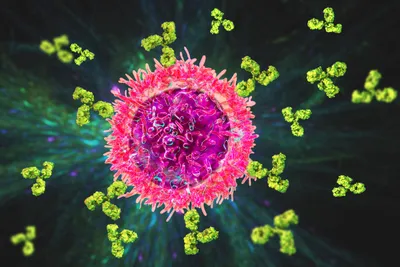Real-world Results for Preventing Infections in CLL and Non-Hodgkin Lymphoma Patients

The results of a new study showed how hypogammaglobulinemia is being tested and treated in patients with chronic lymphocytic leukemia (CLL) and non-Hodgkin lymphoma (NHL). Patients receiving IVIG are less likely to experience severe infections; however, IgG testing is not as common as expected in the real world.
The press release shared important insights from the study and featured Dr. Jacob D. Soumerai, MD, assistant professor of medicine at Massachusetts General Hospital Cancer Center and Harvard Medical School, and the study’s lead investigator.
“This is the first large, real-world study to examine current practices in IgG testing and the use of immunoglobulin replacement therapy among patients with CLL and NHL,” said Dr. Soumerai
They studied the medical records of 17,192 adult patients treated for CLL (3,960) or non-Hodgkin lymphoma (13,232, ~70% diagnosed with B-cell lymphoma) between 2010 and 2023.
- 51.2% of non-Hodgkin lymphoma patients underwent IgG testing and 4.7% received Immunoglobulin replacement therapy (IgRT)
- 67% of CLL patients received IgG testing, and 6.5% were treated with IgRT.
What is immunoglobulin replacement therapy IgRT?
Immunoglobulin G (IgG) specifically, is an antibody found in blood plasma. Low counts of IgG can lead to immune deficiencies and immunoglobulin replacement therapy can help these patients have better immune responses.
IgRT is used to boost IgG levels and help patients overcome infections. However, many patients do not receive regular IgG monitoring at diagnosis, before treatments that can cause hypogammaglobulinemia (like rituximab or obinutuzumab), or after infections.
Routine IgG testing (which measures the immunoglobins G in blood) is rare. There is a lack of consistency in guidelines regarding the timing and frequency of IgG testing, the definition of hypogammaglobulinemia, and when to start IgRT. This study aimed to analyze IgG testing patterns and evaluate the effectiveness of IgRT in reducing infections for CLL and non-Hodgkin lymphoma patients.
What are the Study’s Findings?
The study examined patients with at least one IgG test, comparing IgG levels, infection rates, and antibiotic use at three, six, and 12 months before and after receiving IgRT.
Dr. Soumerai’s team discovered that increased IgG testing is linked to a much lower risk of developing severe infections. Specifically, 86% of non-Hodgkin lymphoma patients and 92% of patients with CLL who had three or more IgG tests had a reduced risk of severe infection.
When assessing IgG levels before and after IgRT initiation, they found a significantly lower number (~20% reduction) of patients with hypogammaglobulinemia after 3, 6, and 12 months. This translated into a lower number of infections and a lower number of patients who needed antimicrobial medication just 3 months after starting IgRT, demonstrating the utility of IVIG to restore the levels of IgG in both CLL and NHL.
“This underlines the urgent need to establish clear consensus on best practices for IgG testing and IgRT use in patients with CLL and NHL, to reduce recurrent infections in our patients,” Dr. Soumerai said.
Final Thoughts
The advantage of a retrospective study is that it analyzes on a greater scale what factors can contribute to improving patient outcomes. Although the sample is large, the minorities are underrepresented since most of the patients in the registry were white, and the study only included patients treated in the Mass General Brigham health care system.
Larger studies are needed to confirm the optimum process for IgG testing and the timing of immunoglobulin replacement therapy for all patient groups to prevent serious infections in more patients.
Learn more from HealthTree’s free webinars!
If you are interested in learning more about CLL and lymphoma, you can participate in our free webinars, where experts answer your questions! Don’t miss our latest webinar: “Caring for the Caregiver: Effective Stress Management Strategies”
Sign in to watch the recording
Sources:
- IgG testing, immunoglobulin replacement therapy, and infection outcomes in patients with CLL or NHL: real-world evidence
- Reduced Infections Seen in CLL and NHL Patients Undergoing Immunoglobin Testing and Replacement Therapy
The results of a new study showed how hypogammaglobulinemia is being tested and treated in patients with chronic lymphocytic leukemia (CLL) and non-Hodgkin lymphoma (NHL). Patients receiving IVIG are less likely to experience severe infections; however, IgG testing is not as common as expected in the real world.
The press release shared important insights from the study and featured Dr. Jacob D. Soumerai, MD, assistant professor of medicine at Massachusetts General Hospital Cancer Center and Harvard Medical School, and the study’s lead investigator.
“This is the first large, real-world study to examine current practices in IgG testing and the use of immunoglobulin replacement therapy among patients with CLL and NHL,” said Dr. Soumerai
They studied the medical records of 17,192 adult patients treated for CLL (3,960) or non-Hodgkin lymphoma (13,232, ~70% diagnosed with B-cell lymphoma) between 2010 and 2023.
- 51.2% of non-Hodgkin lymphoma patients underwent IgG testing and 4.7% received Immunoglobulin replacement therapy (IgRT)
- 67% of CLL patients received IgG testing, and 6.5% were treated with IgRT.
What is immunoglobulin replacement therapy IgRT?
Immunoglobulin G (IgG) specifically, is an antibody found in blood plasma. Low counts of IgG can lead to immune deficiencies and immunoglobulin replacement therapy can help these patients have better immune responses.
IgRT is used to boost IgG levels and help patients overcome infections. However, many patients do not receive regular IgG monitoring at diagnosis, before treatments that can cause hypogammaglobulinemia (like rituximab or obinutuzumab), or after infections.
Routine IgG testing (which measures the immunoglobins G in blood) is rare. There is a lack of consistency in guidelines regarding the timing and frequency of IgG testing, the definition of hypogammaglobulinemia, and when to start IgRT. This study aimed to analyze IgG testing patterns and evaluate the effectiveness of IgRT in reducing infections for CLL and non-Hodgkin lymphoma patients.
What are the Study’s Findings?
The study examined patients with at least one IgG test, comparing IgG levels, infection rates, and antibiotic use at three, six, and 12 months before and after receiving IgRT.
Dr. Soumerai’s team discovered that increased IgG testing is linked to a much lower risk of developing severe infections. Specifically, 86% of non-Hodgkin lymphoma patients and 92% of patients with CLL who had three or more IgG tests had a reduced risk of severe infection.
When assessing IgG levels before and after IgRT initiation, they found a significantly lower number (~20% reduction) of patients with hypogammaglobulinemia after 3, 6, and 12 months. This translated into a lower number of infections and a lower number of patients who needed antimicrobial medication just 3 months after starting IgRT, demonstrating the utility of IVIG to restore the levels of IgG in both CLL and NHL.
“This underlines the urgent need to establish clear consensus on best practices for IgG testing and IgRT use in patients with CLL and NHL, to reduce recurrent infections in our patients,” Dr. Soumerai said.
Final Thoughts
The advantage of a retrospective study is that it analyzes on a greater scale what factors can contribute to improving patient outcomes. Although the sample is large, the minorities are underrepresented since most of the patients in the registry were white, and the study only included patients treated in the Mass General Brigham health care system.
Larger studies are needed to confirm the optimum process for IgG testing and the timing of immunoglobulin replacement therapy for all patient groups to prevent serious infections in more patients.
Learn more from HealthTree’s free webinars!
If you are interested in learning more about CLL and lymphoma, you can participate in our free webinars, where experts answer your questions! Don’t miss our latest webinar: “Caring for the Caregiver: Effective Stress Management Strategies”
Sign in to watch the recording
Sources:
- IgG testing, immunoglobulin replacement therapy, and infection outcomes in patients with CLL or NHL: real-world evidence
- Reduced Infections Seen in CLL and NHL Patients Undergoing Immunoglobin Testing and Replacement Therapy

about the author
Jimena Vicencio
Jimena is an International Medical Graduate and a member of the HealthTree Writing team. She has a passion for languages and is currently learning Japanese. In her free time, she loves playing with her cats. Jimena is also pursuing a bachelor's degree in journalism.
Trending Articles
Get the Latest Mucosa-Associated Lymphoid Tissue Lymphoma Updates, Delivered to You.
By subscribing to the HealthTree newsletter, you'll receive the latest research, treatment updates, and expert insights to help you navigate your health.
Together we care.
Together we cure.
3x Faster.







